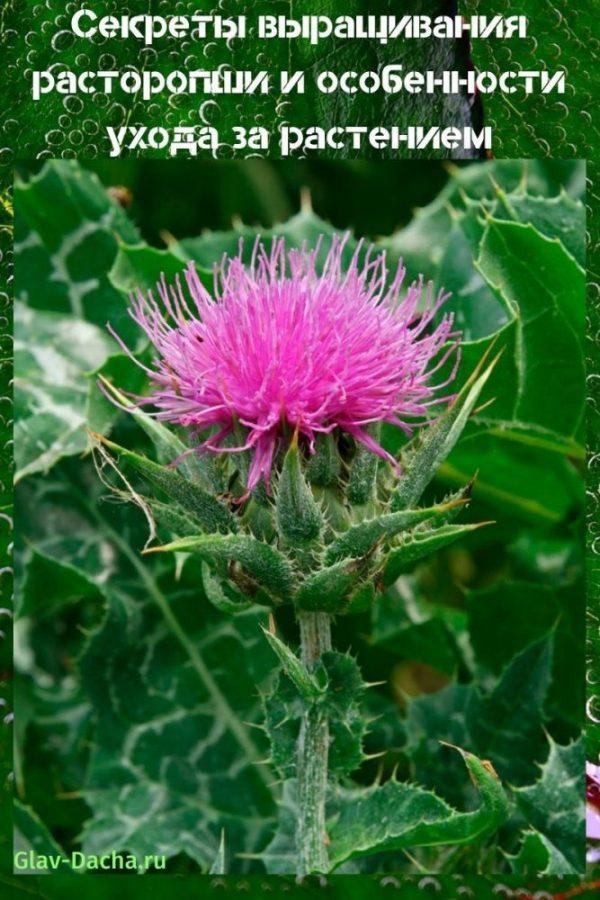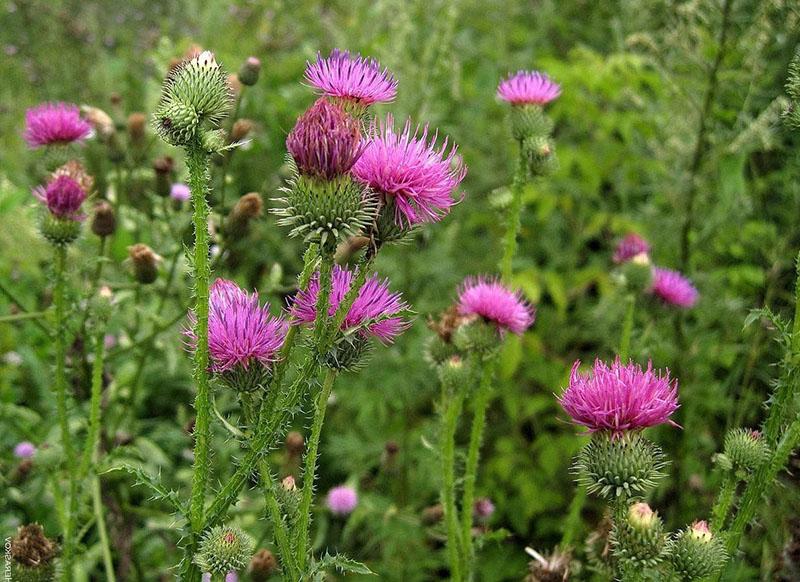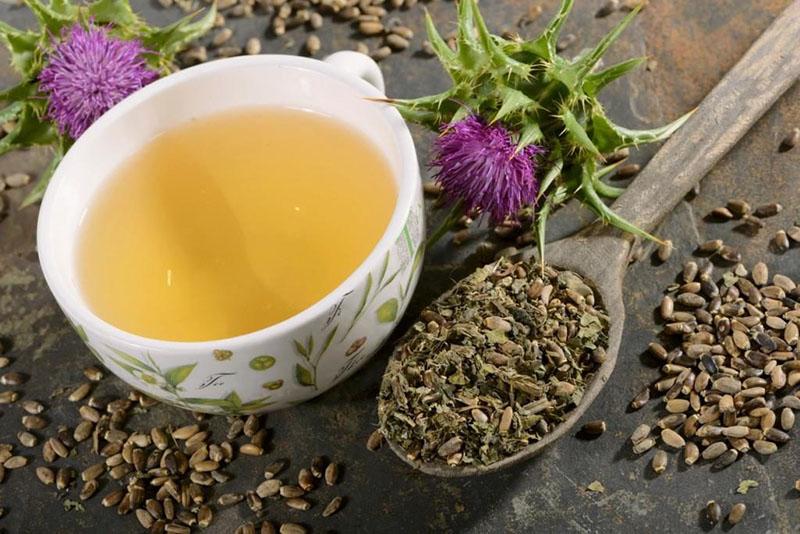Secrets of growing milk thistle and features of plant care
 Milk thistle is a plant with unique properties that is actively used in medicine. The culture has another name - milk thistle, but the shrub belongs to the Aster family. Due to its special composition, the plant contains more than 400 active ingredients. In addition, bright flowers will be a wonderful decoration for any site. Growing milk thistle from seeds does not require complex care or special skills, but some rules must be followed.
Milk thistle is a plant with unique properties that is actively used in medicine. The culture has another name - milk thistle, but the shrub belongs to the Aster family. Due to its special composition, the plant contains more than 400 active ingredients. In addition, bright flowers will be a wonderful decoration for any site. Growing milk thistle from seeds does not require complex care or special skills, but some rules must be followed.

The benefits of the plant
 The root, seeds and leaves of the plant are used as a medicine. Milk thistle is used as an ingredient in many medicines.
The root, seeds and leaves of the plant are used as a medicine. Milk thistle is used as an ingredient in many medicines.
The culture has excellent hepatoprotective properties. Components from it contribute to the removal of harmful substances from the body. The seeds of the plant contain a substance that has an antioxidant effect, therefore it is used to treat complex diseases.
 Different parts of the plant are useful. The sprouts can be eaten and are good for the digestive system. The flowers are first dried and then used as a seasoning for various dishes. Young shoots are soaked and then used to make salads.
Different parts of the plant are useful. The sprouts can be eaten and are good for the digestive system. The flowers are first dried and then used as a seasoning for various dishes. Young shoots are soaked and then used to make salads.
Milk thistle tea has a tonic effect. It is taken for all types of poisoning. The juice from the plant helps with bloating. And seed oil heals wounds.
Milk thistle is also known as an antiviral agent. Its components are used in medicines against hepatitis C. When using such a remedy, the multiplication of viruses slows down.
 The plant is used for flower gardens. It is planted in a rock garden, as it looks good next to rocks and water. Milk thistle fits perfectly into flat rockeries. With the help of a plant, you can create a beautiful green lawn in front of the house. Spectacular shrubs can be planted along the fence.
The plant is used for flower gardens. It is planted in a rock garden, as it looks good next to rocks and water. Milk thistle fits perfectly into flat rockeries. With the help of a plant, you can create a beautiful green lawn in front of the house. Spectacular shrubs can be planted along the fence.
Milk thistle agricultural technology

Milk thistle is a biennial plant. In the first year of growth, a rosette of mottled and yellow leaves with white spots appears. The next year, the rosette transforms into a stem with many branches, which reaches a height of 0.5 to 2 meters. Inflorescences appear in June. The flowers are distinguished by purple-crimson, red-violet or white flowers.
For good crop growth, a soil with a neutral composition, supplemented with a significant amount of calcium, is required. Before planting, you should figure out how to plant milk thistle.
Sowing seeds is carried out in early spring. A sufficient supply of water in the soil is required for high-quality germination. Seeds are sown in rows of 20 cm with a distance of 50 cm between them.
When sowing too densely, after emergence, the plant should be thinned out. This will become impossible as soon as the outlet begins to mature.
 The successful cultivation of milk thistle in the country is impossible without knowledge of some of the features of this plant. On nutritious and loose soil, it begins to fatten. The leaves seem to be covered with oil. If the plant is grown as a medicinal raw material, any soil is suitable for it. A particularly good option is loamy. If the site is swampy, you will need to drain and slightly improve the composition of the soil. If the planting site is well lit, the plant acquires bright and contrasting shades.
The successful cultivation of milk thistle in the country is impossible without knowledge of some of the features of this plant. On nutritious and loose soil, it begins to fatten. The leaves seem to be covered with oil. If the plant is grown as a medicinal raw material, any soil is suitable for it. A particularly good option is loamy. If the site is swampy, you will need to drain and slightly improve the composition of the soil. If the planting site is well lit, the plant acquires bright and contrasting shades.
During dry periods, it is important to periodically moisten the soil. As a result, the leaves will remain fresh and juicy for a long time. For fertilizing, wood ash and complex fertilizers are used.
In order for the plant to branch better, it must be pinched periodically. As a result, the bushes can reach 1.5 meters.
Sowing
 It is better to start growing milk thistle from seeds from late April to mid-May. In the middle lane, the crop is grown as an annual.
It is better to start growing milk thistle from seeds from late April to mid-May. In the middle lane, the crop is grown as an annual.
It is recommended to insulate the sowing site with foil. The plant blooms 45-50 days after germination. Seed collection is carried out in 110-120 days. If desired, the seeds can be planted in early June, so that the plant will decorate the site in the fall. When sowing milk thistle depends on the specific region.
 When purchasing seed, you should pay attention to the expiration date. Seeds from a pharmacy can be stored for a long time and improperly, which contributes to their rapid deterioration.
When purchasing seed, you should pay attention to the expiration date. Seeds from a pharmacy can be stored for a long time and improperly, which contributes to their rapid deterioration.
During the sowing process, the seeds are placed in depressions with a height of 1.5-2.5 cm. The first shoots can be observed in 8-12 days. Milk thistle emerges unevenly.
 The plant can also be grown through seedlings. In this case, the seeds should be planted in late March and early April. For planting, you will need small containers with moist and loose soil. A transplant to a new place is performed after the appearance of four true leaves.
The plant can also be grown through seedlings. In this case, the seeds should be planted in late March and early April. For planting, you will need small containers with moist and loose soil. A transplant to a new place is performed after the appearance of four true leaves.
 This planting will allow you to harvest the seeds ahead of time. Seedlings of plants planted in pots can become a real decoration of the interior. The plant perfectly tolerates transplanting to a permanent place. It is recommended to transplant seedlings in early May. The method of planting through seedlings will allow obtaining medicinal raw materials earlier than when sowing in open ground.
This planting will allow you to harvest the seeds ahead of time. Seedlings of plants planted in pots can become a real decoration of the interior. The plant perfectly tolerates transplanting to a permanent place. It is recommended to transplant seedlings in early May. The method of planting through seedlings will allow obtaining medicinal raw materials earlier than when sowing in open ground.
Before planting in the ground, you need to add 4 kg to the soil humus 1 square meter. You will also need two glasses of ash and 40-60 grams of complex fertilizers.
Milk thistle care

When growing a crop, the following care measures are required:
- The plant grows well in bright areas. It perfectly tolerates exposure to sunlight. It can grow in the shade if necessary.
- Milk thistle is resistant to cold weather. The culture tolerates frosts down to minus 12. This is a heat-loving plant that grows well in hot weather. For its cultivation, no special temperature conditions are required.
- The flower is resistant to drought. Its leaves should only be sprayed on hot days. In winter, you do not need to water it.
- The plant does not need a specific level of moisture. It is enough to spray its leaves every two weeks in the warm season.
- The plant requires mineral fertilizing in a proportion of 1 g per meter. Wood ash, humus and compost are suitable fertilizers. Potassium salt and superphosphates will bring benefits. Urea fertilization is performed in early spring.
 Milk thistle is usually not transplanted, but it can be done easily if needed. To do this, you need a non-acidic and moisture resistant soil. In dry soil, the plant will grow very low.
Milk thistle is usually not transplanted, but it can be done easily if needed. To do this, you need a non-acidic and moisture resistant soil. In dry soil, the plant will grow very low.
It is not necessary to germinate milk thistle seeds, just soak them before sowing. The seed is planted very easily into the nutrient soil and directly into the open ground. Only the soil temperature should not exceed 10 degrees.
For the winter period, the aboveground part of the plant is removed.For proper care, milk thistle must be thinned and watered on time. After heavy rain, the soil must be loosened. If all recommendations are followed, the yield of milk thistle per hectare is 10-15 kg.
Growing milk thistle in a summer cottage will be successful if you know the rules for dealing with dangerous pests. Milk thistle is practically not susceptible to diseases of vegetable crops. Sometimes it is damaged by peach aphids. To get rid of the pest, spraying with a decoction of potatoes, onion peels, tomato tops or a solution of laundry soap is used. In advanced cases, Golden Spark preparations are used and Actellic.
Milk thistle harvesting
 Seeds should be harvested from August to October. This is due to the uneven maturation of the material. If the seeds are ready to be harvested, the basket becomes yellowish and flying parachutes appear. Cutting the fruit begins after the formation of a white cannon in baskets. Achenes are removed with a secateurs. Then they are laid out on a sieve, under which a cloth or newspaper is placed.
Seeds should be harvested from August to October. This is due to the uneven maturation of the material. If the seeds are ready to be harvested, the basket becomes yellowish and flying parachutes appear. Cutting the fruit begins after the formation of a white cannon in baskets. Achenes are removed with a secateurs. Then they are laid out on a sieve, under which a cloth or newspaper is placed.
 After the baskets have dried, you can break them and shake out the seeds. The resulting material must be dried for a week. Then the seeds are collected in a jar. The container can be stored for up to a week.
After the baskets have dried, you can break them and shake out the seeds. The resulting material must be dried for a week. Then the seeds are collected in a jar. The container can be stored for up to a week.
 The roots can be harvested at the same time as the seeds. They are removed from the soil and washed under running water. Then they are crushed and dried. The dried roots are placed in glass containers.
The roots can be harvested at the same time as the seeds. They are removed from the soil and washed under running water. Then they are crushed and dried. The dried roots are placed in glass containers.
To provide yourself with a sufficient number of roots and seeds on the site, it is enough to plant 20 bushes of the plant. This unpretentious flower will greatly benefit the whole family.